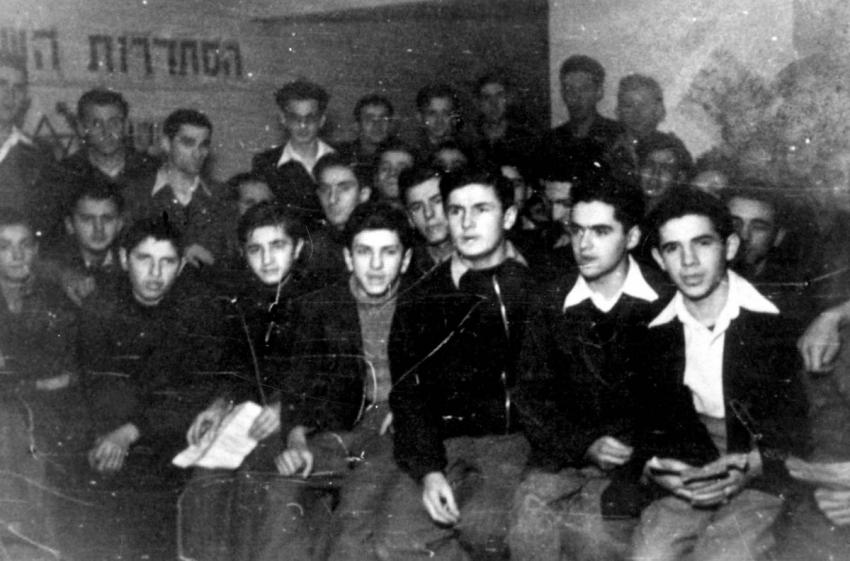The Hashomer Hatzair movement was established in Romania after World War I, and was active until the late 1940s. During World War II, thousands of youngsters were members. Thirsty for idealism, many were German speakers who aspired to socialist Zionism. With that, some had clashes with their parents and teachers, as the piooneering spirit of Hashomer Hatzair's teachings was distracting them from academic study.
In the summer of 1940, Romania was forced to relinquish extensive territories to the Soviet Union and Hungary - Bessarabia, northern Bukovina and northern Transylvania. Dozens of branches of the youth movement in these regions were thus severed from the main body of Hashomer Hatzair in Romania.
From September 1940 –January 1941, the Zionist youth movements in Romania, including Hashomer Hatzair were compelled to go underground. Despite this, in early 1941, the authorities permitted the holding of Zionist movement cultural events. In addition, Zionist training farms operated on the outskirts of Bucharest. However, in early 1942, all Zionist gatherings were outlawed, and the Zionist Hachsharot (pioneer training schemes) were shut down. Despite this setback, the Zionist youth movements continued to form an important part of the Jewish educational system in Romania.
With Romania's invasion of the Soviet Union in the summer of 1941, Hashomer Hatzair activists in Romania went from town to town, without permits and at great personal risk, to relay information and to warn of impending deportations. Many were caught and sent to forced labor by the Romanian authorities. Some were imprisoned on various charges – spreading propaganda, being communist sympathisers, etc. They suffered from antisemitism, and were forced to live in lice-ridden huts where they endured freezing temperatures and hunger, hard labor and physical abuse. Some of these prisoners were girls as young as 12. Some were sentenced to short terms of imprisonment and then deported to Transnistira, where they perished in the ghettos and concentration camps. Others received longer sentences, and were even condemned to death. Many utilized their prison terms for intensive study, including learning Hebrew.
In the summer of 1944, the Red Army neared Romania. The US and Britain intensified their bombardment of Romania, and the fall of the fascist regime there seemed increasingly likely. The pioneer youth movements in Romania started to prepare to defend themselves for fear that the fascist regime would try and attack them in its last moments. They organized themselves into units and distributed arms.
In August 1944, Romania signed an armistice agreement with the Allies, and announced its entry into the war against Nazi Germany. Some 50,000 of the 150,000 Jews deported to Transnistria were still alive. They gradually started returning to Romania, but many locals, who assumed that this return was a Communist-Soviet directive, attacked the Jews for reasons of antisemitism, or because they had no desire to return the Jews' property and businesses to them. Sometimes, the attacks were instigated by the liberating Red Army soldiers, many of whom were antisemitic. Hundreds of Jews were murdered in pogroms that erupted in Romania after the arrival of the Red Army and Romania's entry into the alliance against Nazi Germany.
In this period, the Romanian attitude to Zionism was not unequivocal. Many antisemitic Romanians did not oppose Zionism as it signified the Jews' eventual departure. On the other hand, after the Red Army's arrival, Romania was under strong communist influence, and communism was anti-Zionist. Many Hashomer Hatzair activists faced criminal charges for their Zionist activities, and some were sentenced to imprisonment. In the midst of this charged atmosphere, Hashomer Hatzair activists attempted to renew branch activities throughout Romania. They held a seminar in Bucharest attended by 25 members, many of them former prisoners in Romanian jails. At the seminar, emissaries lectured about current events in Eretz Israel, first reports regarding the enormity of the Holocaust were heard, lessons were given on the Jewish Brigade, the Palmach, the Etzel and Lehi, and Eretz Israel songs and dances were learned. At the end of the seminar, duties were assigned to all the participants. Many were sent to cities and towns all over Romania to establish branches of Hashomer Hatzair, to teach Hebrew and Eretz Israel culture in preparation for immigration. In the photograph are participants at the national seminar in Bucharest in December 1944.
Many of the Hashomer Hatzair activists who survived the Holocaust in Transnistria and Romania set out for Eretz Israel. They were active in the illegal immigration movement, and led groups of youngsters from all the Zionist movements in the detention camps set up by the British in Cyprus.
Yad Vashem Photo Archives 4559/10







